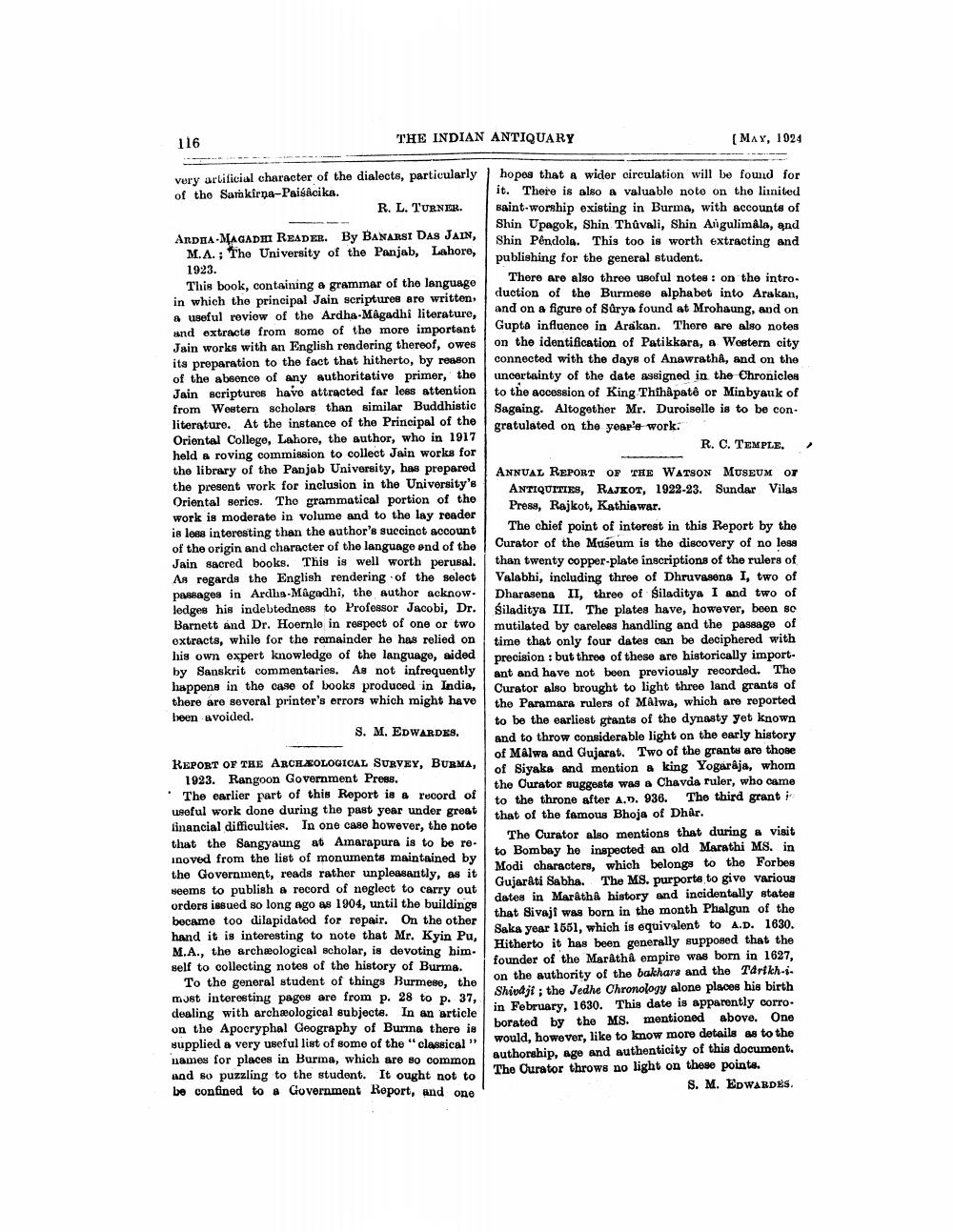________________
116
THE INDIAN ANTIQUARY
(MAY, 1024
very artificial character of the dialects, particularly of the Sarkirna-Paisacika.
R. L. TURNER.
ARDIA-MAGADH READEE. By BANARSI DAS JAIN,
M.A.: The University of the Panjab, Lahore, 1923.
This book, containing a grammar of the language in which the principal Jain scriptures are written, a useful review of the Ardha-Mâgadhi literature, and extracts from some of the more important Jain works with an English rendering thereof, owes its preparation to the fact that hitherto, by reason of the absence of any authoritative primer, the Jain scriptures have attracted far less attention from Western scholars than similar Buddhistic literature. At the instance of the Principal of the Oriental College, Lahore, the author, who in 1917 held a roving commission to collect Jain works for the library of the Panjab University, has prepared the present work for inclusion in the University's Oriental series. The grammatical portion of the work is moderate in volume and to the lay reader is less interesting than the author's succinct account of the origin and character of the language and of the Jain sacred books. This is well worth perusal. As regards the English rendering of the select passages in Archs-Magadhî, the author acknowJedged his indebtedness to Professor Jacobi, Dr. Barnett And Dr. Hoernle in respect of one or two extracts, while for the remainder he has relied on his own expert knowledge of the language, aided by Sanskrit commentaries. As not infrequently happens in the case of books produced in India, there are several printer's errors which might have heen avoided.
S. M. EDWARDES.
hopes that a wider circulation will be found for it. There is also a valuable note on the limnited saint-worship existing in Burma, with accounts of Shin Upagok, Shin Thüvali, Shin Angulimala, and Shin Pendola. This too is worth extracting and publishing for the general student.
There are also three usoful notes : on the introduction of the Burmese alphabet into Arakan, and on a figure of Surya found at Mrohaung, and on Gupta influence in Arakan. There are also notes on the identification of Patikkara, a Western city connected with the days of Anawrath, and on the uncertainty of the date assigned in the Chronicles to the accession of King Thihapatê or Minbyauk of Sagaing. Altogether Mr. Duroiselle is to be con. gratulated on the year's work.
R. C. TEMPLE. " ANNUAL REPORT OF THE WATSON MUSEUM OT
ANTIQUITIES, RAJKOT, 1922-23. Sundar Vilas Press, Rajkot, Kathis war.
The chief point of interest in this Report by the Curator of the Museum is the discovery of no less than twenty copper-plate inscriptions of the rulers of Valabhi, including three of Dhruvasena I, two of Dharasena II, three of siladitya I and two of Siladitya III. The plates have, however, been sc mutilated by careless handling and the passage of time that only four dates can be deciphered with precision : but three of these are historically important and have not been previously recorded. The Curator also brought to light three land grants of the Paramara rulers of Malwa, which are reported to be the earliest gtants of the dynasty yet known and to throw considerable light on the early history of Malwa and Gujarat. Two of the grantu are those of Siyaks and mention & king Yogaraja, whom the Curator suggests was a Chavda ruler, who came to the throne after A.D. 936. The third grant that of the famous Bhoja of Dhår.
The Curator also mentions that during a visit to Bombay he inspected an old Marathi MS. in Modi characters, which belongs to the Forbes Gujarati Sabha. The MS. purports to give various dates in Maratha history and incidentally statee that Sivaji was born in the month Phalgun of the Saka year 1561, which is equivalent to A.D. 1630. Hitherto it has been generally supposed that the founder of the Marath & empire was born in 1627, on the authority of the bakhars and the Tarikh-s. Shivaji ; the Jedhe Chronology alone places his birth in February, 1630. This date is apparently corro. borated by the M8. mentioned above. One would, however, like to know more details as to the authorship, age and authenticity of this document. The Curator throws no light on these points.
S. M. EDWARDES.
KEPORT OF THE ARCHÆOLOGICAL SURVEY, BURMA,
1923. Rangoon Government Press. . The earlier part of this Report is & record of useful work done during the past year under great financial difficulties. In one case however, the note that the Sangyaung at Amarapura is to be reinoved from the list of monuments maintained by the Government, reads rather unpleasantly, as it seems to publish a record of neglect to carry out orders issued so long ago as 1904, until the buildings became too dilapidated for repair. On the other hand it is interesting to note that Mr. Kyin Pu, M.A., the archeological scholar, is devoting him. self to collecting notes of the history of Burma.
To the general student of things Burmese, the must interesting pages are from p. 28 to p. 37, dealing with archæological subjects. In an article on the Apocryphal Geography of Burma there is supplied a very useful list of some of the "classical" names for places in Burma, which are so common and so puzzling to the student. It ought not to be confined to a Government Report, and one




